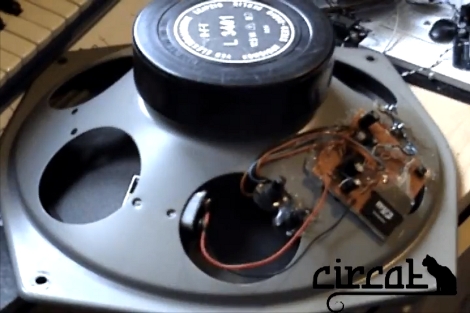
This naked speaker is the basis for [MaoMakMaa’s] newest project called the Wavedrone. He plans on using the autonomous and cable-less device during street performances. You can hear the effect of some stretched jazz cords being played on it in the video clip after the break. The sound is kind of an ethereal background noise that observers might not immediately realize is there.
You can see the 9V battery which serves as the power source clinging to the frame of the speaker. A 7805 linear regulator tames that battery and feeds the two IC’s on the circuit board seen to the right. The ATtiny85 is reading music from an SD card and playing it back in mono (obviously) with the help of an LM386 audio amplifier chip. The trimpots that go into the high pass and low pass filters in between the microcontroller and amplifier allow for a bit of sound manipulation, but we’re more impressed with the quality of the sound this is getting when properly trimmed.
[youtube=http://www.youtube.com/watch?v=WQrElaWKNJo&w=470]















aaaaaaaaaaaaaaaaaaaaaaaaaaaaaaaaaaaaaaaah!
I have *NO* idea what he is doing in that schematic with the op-amp! Colour me confused!
But I do really like the sound. Actually, that’s the part that has me most interested, is how these sounds were generated, but that is not a part of this project, it seems.
Cool!
I think the wrong symbol has been used and it’s actually using a single op-amp in an 8 pin package, e.g. LM386. If you transpose the pinout for the 8-pin dual op-amp shown, it makes more sense. For example, VCC is pin 8 on a LM358, but is for the gain setting resistor on a LM386 which would explain why VCC apparently connects to a variable resistor.
It does say not to trust the schematic!
yeah,sorry,the breadboard is better ;-) i changed the parts for PCB layout , so the schematic is chaos. in the LM386 datasheet is a schematic for the 200x amp,use this one :-) elms-chan.org for sd player schematic :-)
Wait, is that speaker being powered by a 9v battery? I somehow thought that wouldn’t be enough.
A common loudspeaker today will do about 90 decibels with 1 Watt at 1 meters distance. The older loudspeakers with light paper cones and high impendance voice coils were much much more sensitive.
Usually a loudspeaker will turn just a few percent of the input electricity into sound, especially if it’s playing back low frequencies.
“…some stretched jazz cords being played…”
Assuming you are referring to a series of musical notes played at the same time as opposed to rope, cable, wire or some other form of cordage…
…the proper term is chord.
Unless you’re quoting someone’s verbal statement or omitting a portion of your statement, that’s not exactly proper use of ellipses.
Seriously, does it really matter that much to correct a spelling error when it’s not even on the blog being referenced?
Comments were nice for some time but they’re starting to slip into the negative again.
Yes. It does matter.
ur rite we shoodnt car abowt speling n gramur n stuf
It definitely matters. I am constantly amazed at the level of illiteracy that I encounter on a daily basis… This error is a perfect example of someone relying on a spell checker to compensate for their own ignorance. Unfortunately, the spell checker is not any smarter than the user, which is illustrated in this write up ;)
Wow, I don’t know who error-checked that schematic, but that’s pretty pathetic…………………
The irony, of course, is that @Szczys is a musician.
On topic: I built something similar a while ago but was never happy with the amplifier stage. Due to design constraints I had to use a 3V supply with a smaller speaker, and I simply couldn’t get the output power I needed. The project has been unfinished ever since. I think I’ll borrow part of this simple but impressive design to complete my own. Good find, Mike!
Cool. you can make your very own kubrik sound machine.
now you too can add tension and suspense to all your conversations on the go.
Seriously though that is very cool, might have to try and make one myself
what a scarry lookin hand all veins popin out an such
I need that in a backpack form. And it needs to play my theme music!
http://www.youtube.com/watch?v=d0aIqx1McVI
My first thought was “acoustic short-circuit”; when you take a speaker without any housing, the pressure tends to flow around the outer edge of the speaker, which dramatically reduces the efficiency at low frequencies. With the speaker set on the table as it was in the beginning of the video, it occurred to me; you don’t have to use the “front” of the speaker as the “sound output”, you could use the back.
So I think if he would close the front with a board, making sure it’s not touching the cone of rubber outer edge (so you’d probably need a spacer ring), the sounds would come out at the back of the speaker, in all directions. I’d think that might be ideal for street performances.
neat concept, problem is it will not work for “street” because the noise floor on the street is higher than this things output.
A lot of people dont realize how noisy it is out on the “street”
Ignoring the technical details, the words “street performer” and LOUD music are somewhat – ‘troubling’.
Is this fellow planning on subjecting everyone walking by on a public street to HIS taste in music ? (and to hell with what everyone else walking by might think).
Sort of like this nice fellow (who doesn’t have such ‘fancy’ equipment).
http://www.youtube.com/watch?v=Gr82dZpCr48
After watching the video, I think it is possible he used a linear taper pot for the volume control.